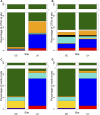Barcoded NS31/AML2 primers for sequencing of arbuscular mycorrhizal communities in environmental samples
- PMID: 28924511
- PMCID: PMC5584815
- DOI: 10.3732/apps.1700017
Barcoded NS31/AML2 primers for sequencing of arbuscular mycorrhizal communities in environmental samples
Abstract
Premise of the study: Arbuscular mycorrhizal fungi (AMF) are globally important root symbioses that enhance plant growth and nutrition and influence ecosystem structure and function. To better characterize levels of AMF diversity relevant to ecosystem function, deeper sequencing depth in environmental samples is needed. In this study, Illumina barcoded primers and a bioinformatics pipeline were developed and applied to study AMF diversity and community structure in environmental samples.
Methods: Libraries of small subunit ribosomal RNA fragment amplicons were amplified from environmental DNA using a single-step PCR reaction with barcoded NS31/AML2 primers. Amplicons were sequenced on an Illumina MiSeq sequencer using version 2, 2 × 250-bp paired-end chemistry, and analyzed using QIIME and RDP Classifier.
Results: Sequencing captured 196 to 6416 operational taxonomic units (OTUs; depending on clustering parameters) representing nine AMF genera. Regardless of clustering parameters, ∼20 OTUs dominated AMF communities (78-87% reads) with the remaining reads distributed among other OTUs. Analyses also showed significant biogeographic differences in AMF communities and that community composition could be linked to specific edaphic factors.
Discussion: Barcoded NS31/AML2 primers and Illumina MiSeq sequencing provide a powerful approach to address AMF diversity and variations in fungal assemblages across host plants, ecosystems, and responses to environmental drivers including global change.
Keywords: Glomeromycota; arbuscular mycorrhizal fungi; barcoding; community composition; diversity; tropical dry forest.
Figures






Similar articles
-
Evaluation of six primer pairs targeting the nuclear rRNA operon for characterization of arbuscular mycorrhizal fungal (AMF) communities using 454 pyrosequencing.J Microbiol Methods. 2014 Nov;106:93-100. doi: 10.1016/j.mimet.2014.08.006. Epub 2014 Aug 27. J Microbiol Methods. 2014. PMID: 25173951
-
Comparison of different PCR primers on detecting arbuscular mycorrhizal communities inside plant roots.Wei Sheng Wu Xue Bao. 2015 Jul 4;55(7):916-25. Wei Sheng Wu Xue Bao. 2015. PMID: 26710610
-
Diverse and abundant arbuscular mycorrhizal fungi in ecological floating beds used to treat eutrophic water.Appl Microbiol Biotechnol. 2021 Sep;105(18):6959-6975. doi: 10.1007/s00253-021-11470-0. Epub 2021 Aug 25. Appl Microbiol Biotechnol. 2021. PMID: 34432133
-
Simulated nitrogen deposition affects community structure of arbuscular mycorrhizal fungi in northern hardwood forests.Mol Ecol. 2011 Feb;20(4):799-811. doi: 10.1111/j.1365-294X.2010.04969.x. Epub 2011 Jan 7. Mol Ecol. 2011. PMID: 21210962
-
Fungal community analysis in seawater of the Mariana Trench as estimated by Illumina HiSeq.RSC Adv. 2019 Feb 28;9(12):6956-6964. doi: 10.1039/c8ra10142f. eCollection 2019 Feb 22. RSC Adv. 2019. PMID: 35518513 Free PMC article. Review.
Cited by
-
Ecological drivers of fine-scale distribution of arbuscular mycorrhizal fungi in a semiarid Mediterranean scrubland.Ann Bot. 2023 Aug 25;131(7):1107-1119. doi: 10.1093/aob/mcad050. Ann Bot. 2023. PMID: 36976581 Free PMC article.
-
Diversity of Arbuscular Mycorrhizal Fungi in Distinct Ecosystems of the North Caucasus, a Temperate Biodiversity Hotspot.J Fungi (Basel). 2023 Dec 24;10(1):11. doi: 10.3390/jof10010011. J Fungi (Basel). 2023. PMID: 38248921 Free PMC article.
-
Biochar is colonized by select arbuscular mycorrhizal fungi in agricultural soils.Mycorrhiza. 2024 Jun;34(3):191-201. doi: 10.1007/s00572-024-01149-5. Epub 2024 May 17. Mycorrhiza. 2024. PMID: 38758247 Free PMC article.
-
Within-Site Variations in Soil Physicochemical Properties Explained the Spatiality and Cohabitation of Arbuscular Mycorrhizal Fungi in the Roots of Cryptomeria Japonica.Microb Ecol. 2024 Nov 4;87(1):136. doi: 10.1007/s00248-024-02449-1. Microb Ecol. 2024. PMID: 39496952 Free PMC article.
-
A metabarcoding protocol targeting two DNA regions to analyze root-associated fungal communities in ferns and lycophytes.Appl Plant Sci. 2023 Jun 12;11(3):e11523. doi: 10.1002/aps3.11523. eCollection 2023 May-Jun. Appl Plant Sci. 2023. PMID: 37342167 Free PMC article.
References
-
- Altschul S. F., Gish W., Miller W., Myers E. W., Lipman D. J. 1990. Basic local alignment search tool. Journal of Molecular Biology 215: 403–410. - PubMed
-
- Augé R. M. 2001. Water relations, drought and vesicular-arbuscular mycorrhizal symbiosis. Mycorrhiza 11: 3–42.
-
- Bainerd L., Bainerd J., Hamel C., Gan Y. 2014. Spatial and temporal structuring of arbuscular mycorrhizal communities is differentially influenced by abiotic factors and host crop in a semi-arid prairie agro-ecosystem. ISME Journal 88: 333–344. - PubMed
-
- Baykov A., Evtushenko O. A., Avaeva S. M. 1988. A malachite green procedure for orthophosphate determination in alkaline-phosphatase-based enzyme immunoassay. Analytical Biochemistry 171: 266–270. - PubMed
-
- Brundrett M. C. 2009. Mycorrhizal associations and other means of nutrition of vascular plants: Understanding the global diversity of host plants by resolving conflicting information and developing reliable means of diagnosis. Plant and Soil 320: 37–77.
LinkOut - more resources
Full Text Sources
Other Literature Sources
Research Materials

